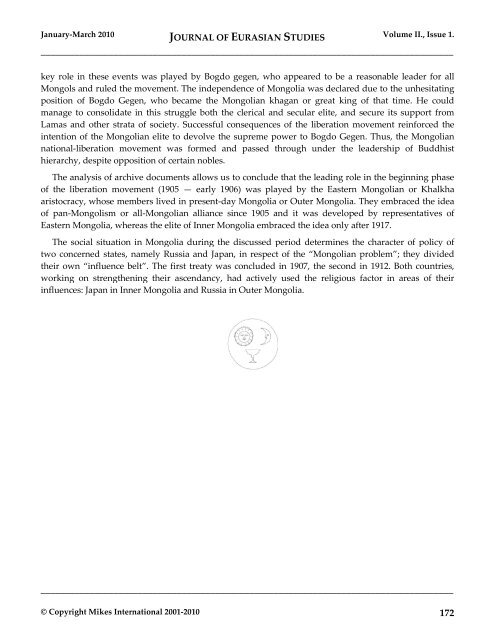EurasianStudies_0110..
EurasianStudies_0110..
EurasianStudies_0110..
Create successful ePaper yourself
Turn your PDF publications into a flip-book with our unique Google optimized e-Paper software.
January-March 2010 JOURNAL OF EURASIAN STUDIES Volume II., Issue 1.<br />
_____________________________________________________________________________________<br />
key role in these events was played by Bogdo gegen, who appeared to be a reasonable leader for all<br />
Mongols and ruled the movement. The independence of Mongolia was declared due to the unhesitating<br />
position of Bogdo Gegen, who became the Mongolian khagan or great king of that time. He could<br />
manage to consolidate in this struggle both the clerical and secular elite, and secure its support from<br />
Lamas and other strata of society. Successful consequences of the liberation movement reinforced the<br />
intention of the Mongolian elite to devolve the supreme power to Bogdo Gegen. Thus, the Mongolian<br />
national-liberation movement was formed and passed through under the leadership of Buddhist<br />
hierarchy, despite opposition of certain nobles.<br />
The analysis of archive documents allows us to conclude that the leading role in the beginning phase<br />
of the liberation movement (1905 — early 1906) was played by the Eastern Mongolian or Khalkha<br />
aristocracy, whose members lived in present-day Mongolia or Outer Mongolia. They embraced the idea<br />
of pan-Mongolism or all-Mongolian alliance since 1905 and it was developed by representatives of<br />
Eastern Mongolia, whereas the elite of Inner Mongolia embraced the idea only after 1917.<br />
The social situation in Mongolia during the discussed period determines the character of policy of<br />
two concerned states, namely Russia and Japan, in respect of the “Mongolian problem”; they divided<br />
their own “influence belt”. The first treaty was concluded in 1907, the second in 1912. Both countries,<br />
working on strengthening their ascendancy, had actively used the religious factor in areas of their<br />
influences: Japan in Inner Mongolia and Russia in Outer Mongolia.<br />
_____________________________________________________________________________________<br />
© Copyright Mikes International 2001-2010 172

















